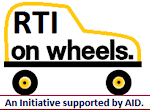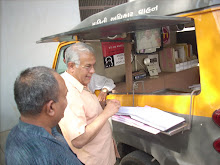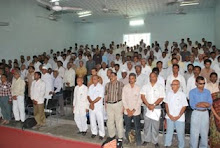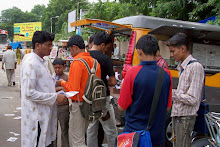Hindu
Business Line: National: Saturday, 19 December 2015.
Much like
rice spilling out of a tear in the sack, the country’s food procurement system
has been leaking crores of rupees every year and impoverishing the government.
Last week, in
a report presented to Parliament the Comptroller & Auditor General (CAG)
has attempted to calculate the siphoned-off amount, although this was based on
incomplete data.
The report
concluded that delays in price revisions, as also poor control (by State and
Central governments) had over the years led to “undue gains for rice millers”
and, more importantly, non-delivery of paddy and rice to the national food
stock.
Based on the
conservative and incomplete figures given by the CAG, the total losses exceed 40,000
crore. An all-India estimate is expected to show double the losses under all
heads. To calculate the actual (and expectedly higher) loss to the exchequer,
the CAG has recommended a thorough probe.
This story of
plunder is as much about corruption as it is about a few good men fighting the
system for years and bringing this information into the public domain.
From rural
Orissa, Gouri Shankar Jain has been working to expose this loot and bring to
account those responsible. The stacks of supporting documents he has secured
through the Right to Information (RTI) Act prove that a problem exists. His
relentless pursuit of the matter at the highest levels forced the Prime
Minister’s Office (PMO) to forward the case to the CAG for an audit early this
year.
Jain has also
forwarded the proof to the Central Bureau of Investigation (CBI), which is now
investigating the matter.
During rice
milling, husk, bran and broken rice emerge as by-products and these are sold by
the millers. In the last decade, the rates for each of these items have
increased, as have the profits for millers.
Successive
governments have ignored this revenue and failed to tax it. Based on partial
data from four states over a two-year period, which covers just 15 per cent of
the rice procured, the CAG pegs the loss at ₹3,743 crore. When extended to the
countrywide procurement, the loss could cross ₹23,000 crore.
“The government has not revised milling
charges for over 20 years; we are paid up to ₹25 for every quintal of rice,
when we spend about ₹200 on milling and supplying it,” says Tarsem Lal Saini,
president of the Rice Mill Association of Punjab.
“Over 300
rice mills have shut down due to losses, even as paddy worth over ₹10,000 crore
has been sold to distilleries after rotting. The only reason we continue to
work under the 20-year-old rates is because we earn from the by-products,” he
adds.
The day the
CAG report was presented in Parliament, the Central government put out a
statement that milling charges were decided after taking into account the
prices of by-products of paddy. It however conceded that rates had not been
revised since 2005 and a study by the Tariff Commission in 2012 had not made
any recommendations owing to a lack of data.
As the
government continues to turn a blind eye, the rot is eating into the country’s
food security. Over the last 5 years, the subsidy bill of the Central Government
has almost doubled, while the amount of rice procured has reduced.
In Punjab,
irregular expenditure on transportation cost the exchequer ₹164 crore;
rice-mill owners pocketed more than ₹475 crore by supplying inferior quality
rice, and another windfall gain of ₹160 crore from waiver of penal interest on
delayed deliveries, according to the CAG report.
Dubious
claims of transportation charges led to a loss of ₹210 crore. More than 97 per
cent of the registration numbers of vehicles that were allegedly used to
transport paddy did not match the computerised data of the State Transport
Authority. Those that did were found to be motorcycles, cars, taxis or buses.
Some of the
highest figures came from Andhra Pradesh the release of VAT (value added tax)
gave millers here an additional benefit of ₹1,024 crore, even as rice worth
₹1,195 crore was retained by them for undue profit.
In
Chhattisgarh, improper storage of paddy led to loss of ₹180 crore. The State
government admitted to the charge that for the last four years it had purchased
rice without any quality checks. “It is not clear how the State government
ensured the minimum quality standard,” said the CAG report.
“Chhattisgarh
has had such a huge growth in rice production in the last 10 years that the
system to check it has not kept pace,” Saini says. A demand from Punjab in 1998
for an extra one per cent ‘driage’ (compensation for loss of moisture) was
converted into a countrywide policy without any expert consultation, leading to
a payment of ₹952 crore from the exchequer.
“On every
37kg bag of paddy that we get, we lose up to one kilogram to drying,” maintains
Saini. According to a Central government directive, this ‘driage’ is taken into
account when computing that 67kg of rice is produced from 100kg of paddy.
Most
importantly, about ₹17,985 crore was released as MSP (minimum support price) to
farmers, but the recipients could not be verified as there were no identity
documents in support. “This raises a doubt as to whether the benefit of MSP did
actually accrue to farmers,” the report states cautiously.
“This is an
issue that is close to the hearts of 70 crore farmers in India. I am fighting
for them, this is just the beginning,” says Jain.
Now that the
information has been released to the people’s representatives, it remains to be
seen whether they show the willingness to wage the long battle needed to return
this money to the public and penalise the guilty.














































































